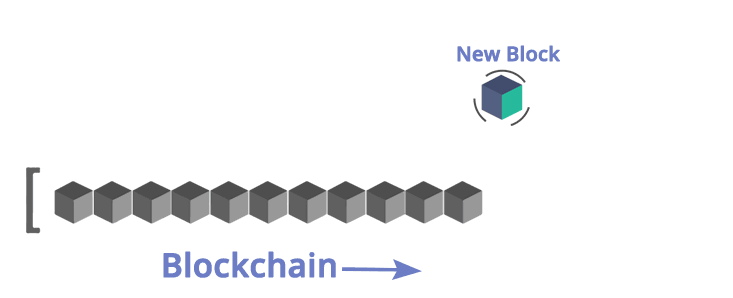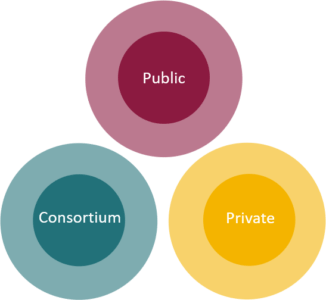Blockchain Developer Certification Course
- 25k Enrolled Learners
- Weekend
- Self Paced
Psyched about the rise in cryptocurrency? Want to know how Blockchain Technology works? You have landed at the right place. This blog will clear your muddled head and you’ll have a better understanding of the blockchain.
Following will be the learning of this blog:
Heads up before I begin!!
Ever imagined a system so secure & powerful that could transform the way that our economy, governance systems, businesses functions, and might transform our conceptual sense of trade, ownership and also trust. Well, such a technology already exist and is called Blockchain.
Seems fascinating? Let’s unravel this mystery together…
Blockchain is a backlinked, decentralized and distributed-database of encrypted records.
Okay, if those words seem bemusing, then let me break it down for you:

As blockchain didn’t conceptualize as a single separate entity in itself, it was the backbone technology of bitcoin, so we shall try to understand it with the use case of bitcoin & how does it help securely transfer this “digital gold”.
Consider a Bitcoin transaction where, James transfer 5 BTC his friend, Kevin in the network.
Now, this transaction is broadcast to the Bitcoin Blockchain network, and the special nodes called Miners who takes up this transaction from the pool of unconfirmed transactions, validate it and adds it to their block.
Here, suppose Lisa and Robert are miners, they verify the transactions in the network and groups the verified transaction in a block and start competing to solving a complex mathematical puzzle called Proof-of-work.
If Lisa here solves the puzzle first, she broadcast the block to the entire network. The other miners validate the block and every node unanimously agrees to the current state of the ledger, each updating the record independently. Thus James and Kevin get a verification message that the transaction is completed.
The transaction thus becomes a part of the universal distributed ledger (or Blockchain). And, For her computational work, Lisa is rewarded with newly created Bitcoins (hence the term mining). The current reward for each block is 12.5 Bitcoins.
“So the digital money is transferred from one person to another without the use of third parties we use in our conventional system. Isn’t that amazing?!”
Yet, Blockchain Technology, for all its virtue is not a new technology.
Passably, it is an amalgamation of potent technologies in a new way.

Blockchains are secured with strong state-of-the-art cryptographic mechanisms. Everything stored on the Blockchain is encrypted.
To give you a better idea of how it is used in Blockchain, let’s get back to our previously discussed example where Kevin transfers 5 BTC to James. This transaction goes into the network in the form of an encrypted message. This message is unique is for every transaction.
Now, you would ask what makes the message unique? It is because the transaction is signed by the senders unique key called a private key, hence the digital signature. The mechanism looks something like this:
Miners verify this digital signature for validating a transaction in the network.
Cool.Isn’t it? Let me tell you some more fascinating stuff. Ever seen these numbers before: 09bed8e02e49277378f256c9d93ba4e408771088483f3955c6b1186ac8c7630a. Looks gibberish right? Well, it’s called Secure Hashing Algorithm (SHA-256).
The function is so powerful that if you pass anything through this algorithm, it gives you a digital fingerprint of that input. Even if a single space is altered, the fingerprint changes completely.
Wondering how is it used in Blockchain? Remember I told you that blocks are back linked to each other in Blockchain. Well, there you go. If you do the hashing of a bunch of transactions i.e. give that whole ‘block’ of transactions a unique fingerprint!That is it.
Now, your next block of transactions has the new transactions — plus that hash from the previous block.
And this is how the blockchain system is made cryptographically secure.
Blockchain uses distributed network where two or more nodes work with each other in a coordinated fashion in order to achieve a common outcome.X All users on the Blockchain are nodes (or peers) who maintain their own ledger.
Faster transaction process makes the validation process swift for the peers. This ultimately results in the faster transfer of digital assets. |  |
Blockchain uses network servicing protocol for smooth and secure running of the system. The nodes serve the network by maintaining a record of transactions. The verification process can be customized for each blockchain. Basically, it is the consensus mechanism that governs the network of Blockchain. Example Proof-of-work in Bitcoin Blockchain.
Consensus does two things:
Faster transaction process makes the validation process swift for the peers. This ultimately results in the faster transfer of digital assets. |  |
I guess now you know how these conventional concepts are being used in Blockchain technologies. Let me show you the visual graphics of how the system works
Alright so, let’s move on and discuss the types of blockchains.

Public: Public blockchains have ledgers visible to everyone on the internet and anyone can verify and add a block of transactions to the blockchain.
Examples – Bitcoin, Ethereum, Dash, Factom
Private: all permissions are kept centralized to an organization. Private blockchains allow only specific people in the organization to verify and add transaction blocks but everyone on the internet is generally allowed to view.
Examples- Multichain, Blockstack
Consortium: controlled by a consortium of members. Only predefined set of nodes have access to write the data or block.
Examples- Ripple ,R3 & Hyperledger1.0

Monetary Aspect is just a tip of the iceberg of blockchain Technology. Blockchain is a ground-breaking technology for which money is merely one of the possible applications.
Following are some real-life applications of Blockchain:

Let me now show you where the Blockchain technology is going to lead us in the
near future.
According to the census of world economic forum, following advancement is expected from the blockchain technology.

So this concludes our Blockchain Technology blog. I hope you enjoyed reading this blog and found it informative. To learn more about the blockchain, watch our video on “Blockchain Technology”
Got a question for us? Please mention it in the comments section and we will get back to you at the earliest.
If you wish to learn about Blockchain Technology and master the concepts of Cryptography, Blockchain Networks, Smart Contracts, Ethereum and the Hyperledger, check out our interactive, live-online Blockchain Certification here, that comes with 24*7 support to guide you throughout your learning period.
 Thank you for registering Join Edureka Meetup community for 100+ Free Webinars each month JOIN MEETUP GROUP
Thank you for registering Join Edureka Meetup community for 100+ Free Webinars each month JOIN MEETUP GROUPedureka.co
Hello shashank sir, I am doing my project of last year in Blockchain . I have taken ethereum as platform for devloping a simple votting application, I have read the various research paper then I came to conclusions that on Blockchain technology there are various attack such as 51 % , Sybil , eclipse So can it be possible to perform those attack practically on app.?
Sir,
I am a junior banking professional in credit/finance division, who would like to gain knowledge/expertise in Blockchain technology. But I do not have a software coding background or programming knowledge and has experience only in bank transaction processing and monitoring.
1. Will it be beneficial for me to learn Blockchain technology in terms of its implementation(not programming) and final usage?
2. If yes, which online course/certification will you recommend to get into, that will help my career progression in any way??
Thanks and regards,
AJI C VARGHESE
Dubai, UAE
+971-581843902
Hello Aji,
Glad to hear from you. Since you have a professional background in finance, Blockchain could be really helpful for you. Now, considering that you are not from software background, you need a step by step structured learning path. To start with, you can watch some introductory videos.
Now, after getting head start in the technology, you can consider this online course from edureka: https://www.edureka.co/blockchain-training
In this course you’ll get in depth understanding of the Blockchain technology. Also, you will be introduced to development in Blockchain (Ethereum, Hyperledger).
Join the revolution, become a Blockchain Evangelist